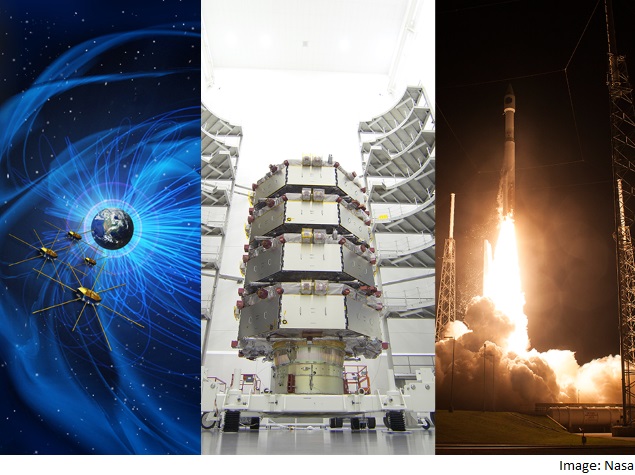- Home
- Science
- Science News
- Nasa's MMS Mission to Decode Explosive Interplay of the Earth and Sun
Nasa's MMS Mission to Decode Explosive Interplay of the Earth and Sun

During the mission's first phase, the spacecraft will travel through reconnection sites on the Sun-side of Earth where the orbit extends out toward the Sun to around 47,500 miles.
Nearly one year later, ground controllers then will move the spacecraft to Earth's night-side or magnetotail where the magnetic fields also reconnect an orbit that extends away from Earth to almost 99,000 miles, nearly halfway to the moon.
The Magnetospheric Multiscale (MMS) mission was launched aboard a United Launch Alliance Atlas V 421 rocket on March 12 this year.
The aim is to study the high-speed interactions between Earth's magnetic field and the Sun to learn more about the mechanisms responsible for energy discharges that drive auroras and play havoc with satellite navigation, communications and power grids.
However, science operations can't begin before the four satellites move into a highly elliptical orbit and assume their pyramid-shape formation that places the spinning spacecraft just 10 km apart.
"It required a breakthrough to accomplish such an exacting formation and the Navigator GPS provided the solution," said Brent Robertson, deputy project manager of the MMS mission from Goddard Space Flight Center in Greenbelt, Maryland.
The four spacecraft are equipped with 25 sensors and other components provided by more than 40 partner institutions in the US, Europe and Japan.
When fully deployed, each satellite's booms will sweep out an area the size of a baseball field as the spacecraft slowly rotates. All the four satellites will be arranged in a pyramid formation, flying within about six miles of each other at their closest.
"No one has done what we are going to do," said MMS deputy mission systems engineer Gary Davis.
Because the MMS spacecraft must maintain a precise formation, the mission also needed the ability to not only determine the immediate locations of the four observatories, but also predict where they would be in the future and how fast they would be travelling.
Providing that predictive data is the Goddard Enhanced Onboard Navigation System (GEONS). Communicating commands to the MMS fleet also required the MMS team to rethink the onboard hardware it would use.
For this, the Goddard team developed a diminutive S-band antenna that met the mission's communications requirements.
"With this data, we will be seeing more than we could before," the researchers said, adding that "this mission was a long time coming and we are anxious to reap the rewards".
For the latest tech news and reviews, follow Gadgets 360 on X, Facebook, WhatsApp, Threads and Google News. For the latest videos on gadgets and tech, subscribe to our YouTube channel. If you want to know everything about top influencers, follow our in-house Who'sThat360 on Instagram and YouTube.
- Galaxy S24 Series
- MWC 2024
- Apple Vision Pro
- Oneplus 12
- iPhone 14
- Apple iPhone 15
- OnePlus Nord CE 3 Lite 5G
- iPhone 13
- Xiaomi 14 Pro
- Oppo Find N3
- Tecno Spark Go (2023)
- Realme V30
- Best Phones Under 25000
- Samsung Galaxy S24 Series
- Cryptocurrency
- iQoo 12
- Samsung Galaxy S24 Ultra
- Giottus
- Samsung Galaxy Z Flip 5
- Apple 'Scary Fast'
- Housefull 5
- GoPro Hero 12 Black Review
- Invincible Season 2
- JioGlass
- HD Ready TV
- Laptop Under 50000
- Smartwatch Under 10000
- Latest Mobile Phones
- Compare Phones
- Tecno Camon 30 Premier 5G
- Motorola Edge 50 Fusion
- Oppo A1i
- Oppo A1s
- Motorola Edge 50 Ultra
- Leica Leitz Phone 3
- Moto G64 5G
- Moto G04s
- Asus ZenBook Duo 2024 (UX8406)
- Dell Inspiron 14 Plus
- Realme Pad 2 Wi-Fi
- Redmi Pad Pro
- Cult Shock X
- Fire-Boltt Oracle
- Samsung Samsung Neo QLED 8K Smart TV QN800D
- Samsung Neo QLED 4K Smart TV (QN90D)
- Sony PlayStation 5 Slim Digital Edition
- Sony PlayStation 5 Slim
- Blue Star 1.5 Ton 4 Star Inverter Split AC (ID418YNU)
- IFB 1.5 Ton 5 Star Inverter Split AC (CI1852A323G2)












